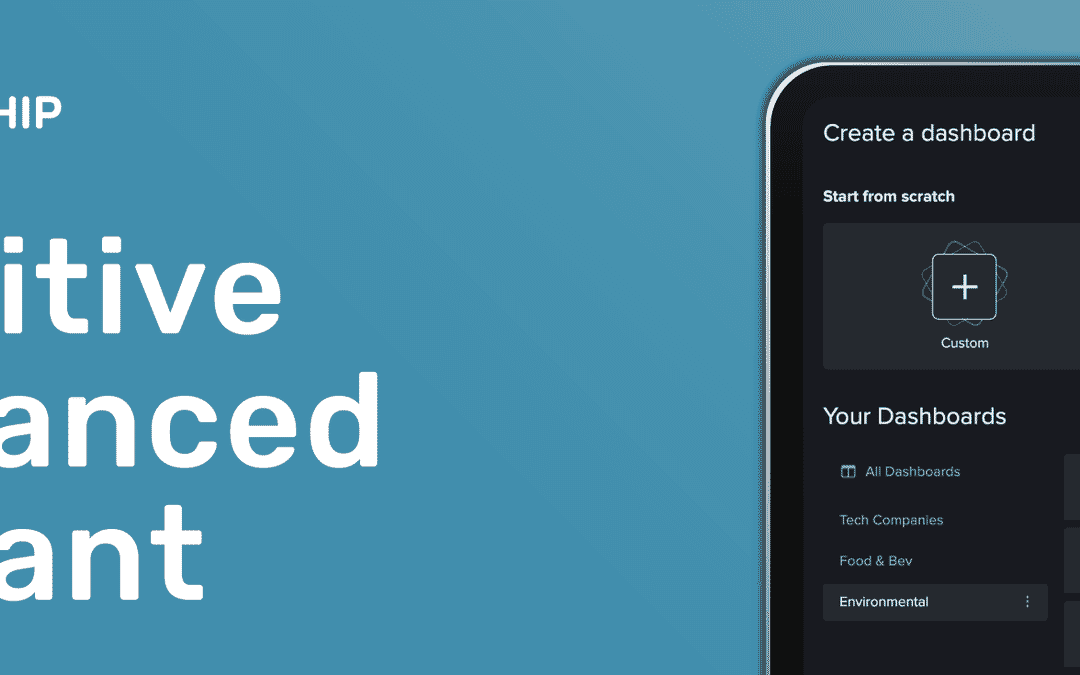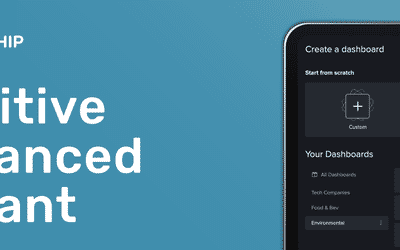For brands, celebrity spokespeople are a time-honored tradition, with endorsements from athletes, actors, and celebrities a key part of marketing efforts for decades. However, tying your brand to an individual can have negative consequences as well as positive ones, as statements or actions by that individual can then be associated with your brand by the broader public.
That happened this week with NFL star Aaron Rodgers, who tested positive for Covid-19 and eventually revealed that he had not taken the vaccine during a controversial radio show in which he criticized the media and the ‘woke mob’.
Rodgers’ partners were quick to act, with Prevea Health ending their partnership and State Farm saying that while they support individual choice, they do encourage their followers to get vaccinated.
Let’s take a look at how a brand like State Farm could make sure they’re up to date with what their partners are saying that may affect reputation.
Discovering the situation as part of your brand monitoring activities
While many potential crises are identified by companies well before they are mentioned in the media, sometimes they may be discovered during your ongoing brand monitoring.
To do this with NewsWhip Spike, you would create a dashboard for your brand, with a simple search such as “State Farm”, or whatever your brand interest terms may be. That shows you the Timeline of public and media interest, and you can add content feeds of articles published on the web, posts from social networks such as Twitter, Facebook, Reddit, Instagram, and YouTube, and leaderboards of the websites, journalists, and subreddits that mention your brand.
The image below shows a dashboard with a Timeline analysis graph of interest in the two days up to the Aaron Rodgers interview with Pat McAfee.
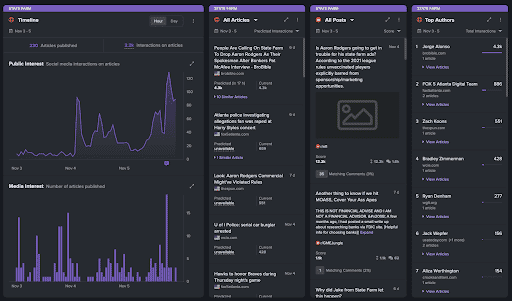
If you expand our Timeline to focus on public interest, here’s what it looks like before the radio interview. The biggest article coincidentally was about how a TV commercial with Aaron Rodgers might have violated Covid rules, but this had nothing to do with his Covid-19 result, or his interview with Pat McAfee.
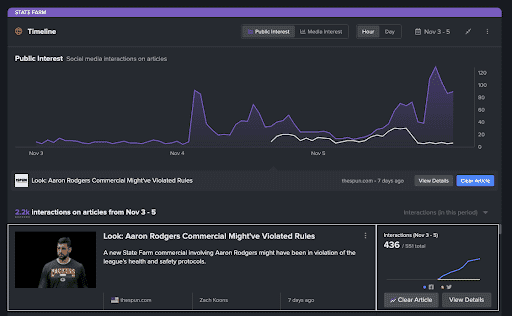
However, you can see that from November the 5th, public interest picked up on calls to drop Aaron Rodgers from State Farm’s sponsorship. The previous commercial rules violation suddenly seems insignificant when you see the spike in public interest related to one of the early articles from Brobible.
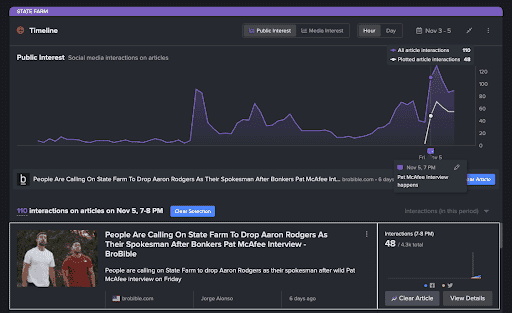
Thanks to the Compare feature, you could also monitor all of your major brand ambassadors in a single dashboard.
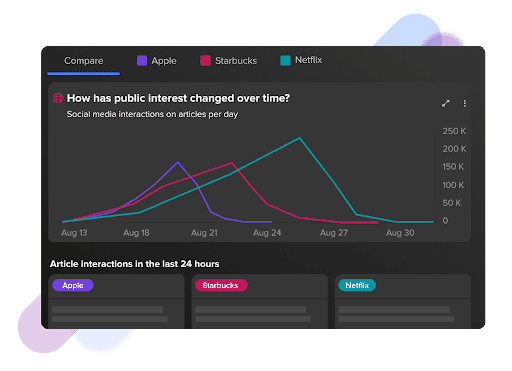
Compare allows you to visualize how much media and public interest your ambassadors are getting in a single view. Real-time content feeds would also inform you on the articles that mention these ambassadors.
You could then use alerts to let you know via email or Slack, when any articles or social posts mentioning an ambassador are quickly growing in popularity. This means you don’t always have to monitor your dashboards actively, and NewsWhip can do much of the hard work for you.
Having an ambassador dashboard like this at the ready would allow you to quickly add your saved Aaron Rodgers search into a specific crisis dashboard following the Pat McAfee interview.
If we add in a Timeline of interest for Aaron Rodgers into the Compare view, you can see below that Aaron Rodgers completely eclipsed any mentions of the brand up until the radio interview.
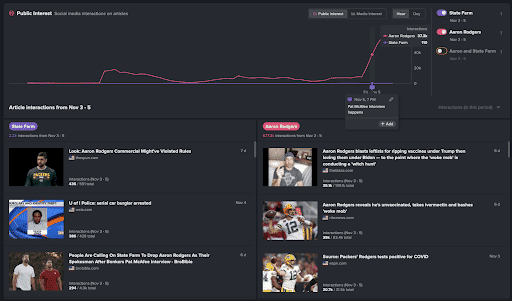
Once the interview aired, interactions on articles about Aaron Rodgers grew from 128k on November 4th, all the way to 1.04 million by November 9th.
Most interestingly for State Farm, or any brand comms team, public interest in articles mentioning State Farm jumped from 1k interactions on November 4th to 385k on November 9th.
The below graph shows that public interaction with articles mentioning State Farm made up over 35% of the engagement with the story at its peak, despite only accounting for 7% of the total articles published since November 4th.
Interestingly, while public interest in stories about Aaron Rodgers began to increase as soon as the interview aired, the graph below shows that it took 3 days before State Farm began to become part of the conversation. This shows how important it is for brands to track their ambassadors, as it gives crucial time to prepare before being brought into the conversation the way State farm clearly was.
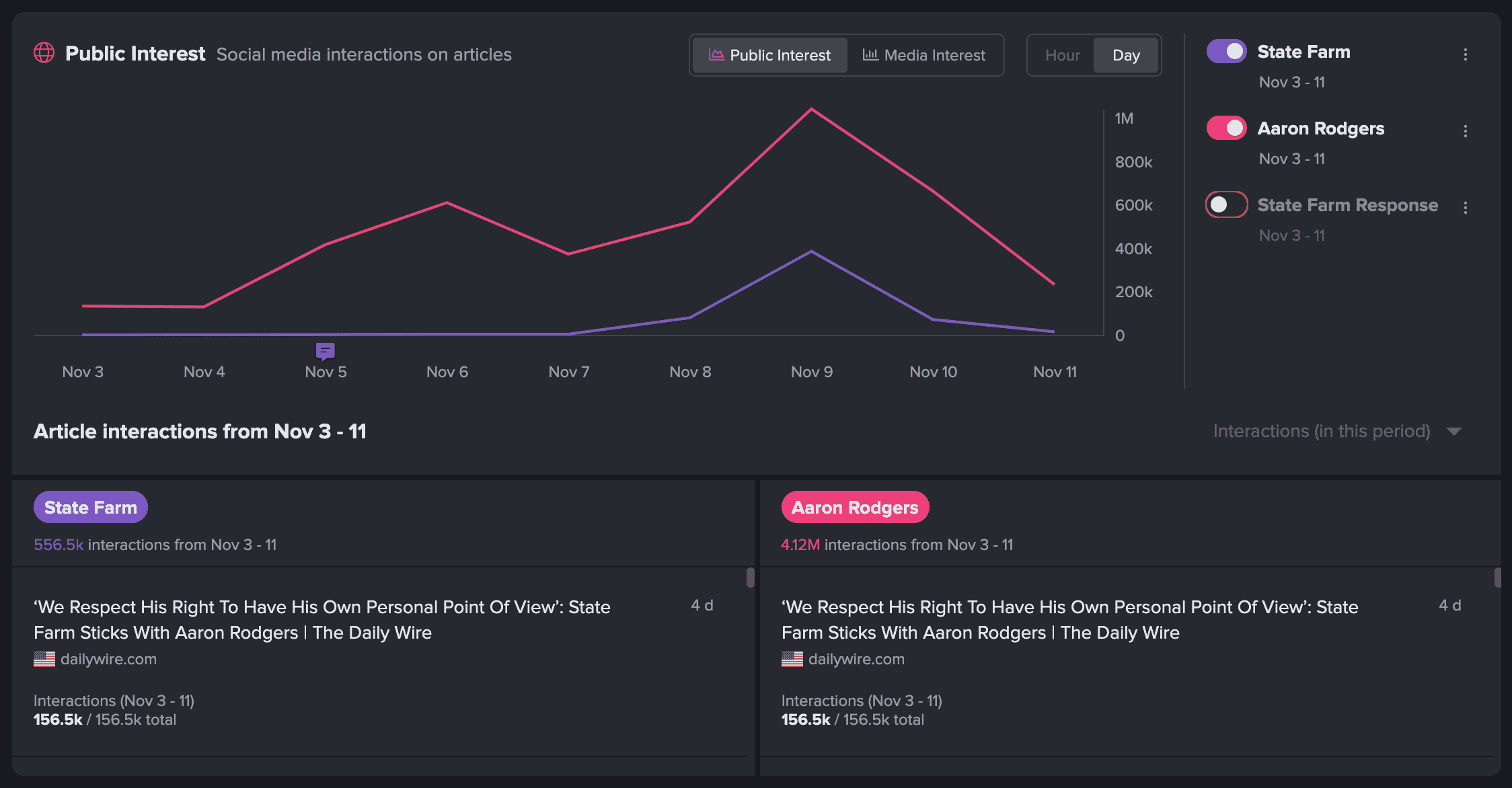
So, how would you deal with a crisis like this using NewsWhip Spike?
First, assess the situation
As you saw above, Timeline is giving us a real-time visual overview of public interest and media interest. Here’s what it looks like as of November 11th. When doing this in real time, early on November 8th it would be clear that public interest was growing. This was ahead of the media interest peaking later on November 8th. This shows how important it is to pay attention to real-time public interaction, and predict public interest so you can act fast with data informed decision making.
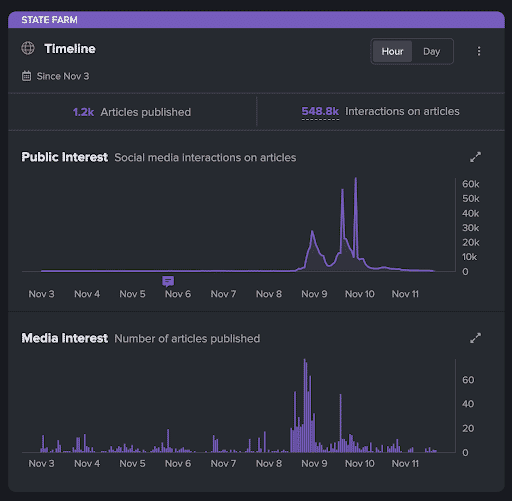
Once you know that the overall story is growing in public interest, you can expand the web articles widget and sort by predicted interactions. This will show which individual articles are predicted to become the most popular, and allows you to identify the most popular narrative that is influencing the public.
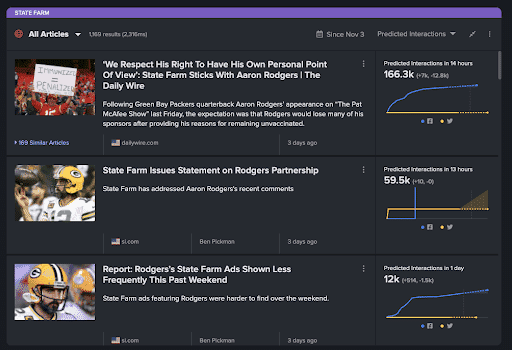
On top of that, you can sort by Highest Velocity. Highest Velocity will quickly show you the fastest growing articles and Facebook posts in terms of public interest. This is perfect for finding the most viral content at any point in time.
You can then use our social media feeds to check the media narrative against the public conversation. Here’s a look at our expanded Reddit widget which gives you all of the posts and comments to show what the public are saying in reaction to the story.
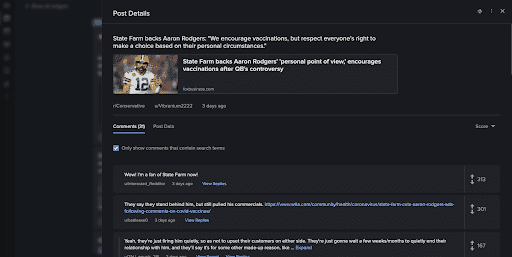
One of the most useful features of NewsWhip Spike are the alerts. You can trigger alerts based on multiple factors. Trigger alerts based on:
- Any newly published articles
- Articles that have hit a threshold of public engagement
- Articles that are predicted to hit a threshold of public engagement
The latter is one of the most powerful features in a time of crisis, so you can ensure you know about the articles that matter, and cut out the ones that don’t.
In addition to the real-time and predictive alerts, you can set up a scheduled alert to hit your inbox as often as every 30 minutes or up to a daily frequency, so you can stay on top of the articles published on a regular basis.
Once you have an understanding, decide whether to react
You can continue to use Timeline to track the crisis, and based on the level of interest and public conversation, you might decide to react.
To help you respond, you can use NewsWhip Spike leaderboards to find the authors and websites that are talking most about the crisis. This allows you to rank authors by articles published, average interactions per article, and total interactions for all articles.
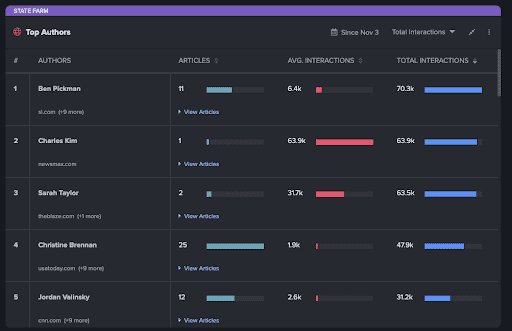
If you do, you can add in a search to your Timeline to track your response. To do this, you can use unique key terms that isolate your response.
In the case of State Farm, you might want to add a Boolean search along the lines of:
“State Farm” AND (Statement OR support* OR backs OR “stands by” OR “personal point of view”)
This allows you to see your statement in the context of the entire conversation. Here’s what it looks like, with the yellow line showing the level of engagement with the response:
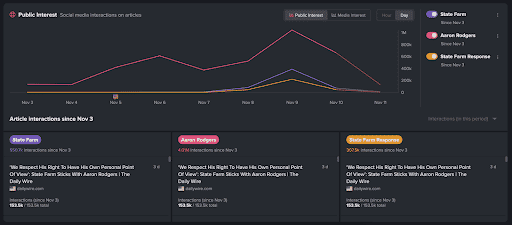
What’s interesting here is that while there were only 85 articles from the media covering the State Farm response, public engagement was at 307k, mostly driven by conservative publications.
Once you know this, you can quickly share updates with your team, or if you’re a PR agency managing this for a brand, you can share it with your clients using our new Timeline export feature. Here’s how that looks:
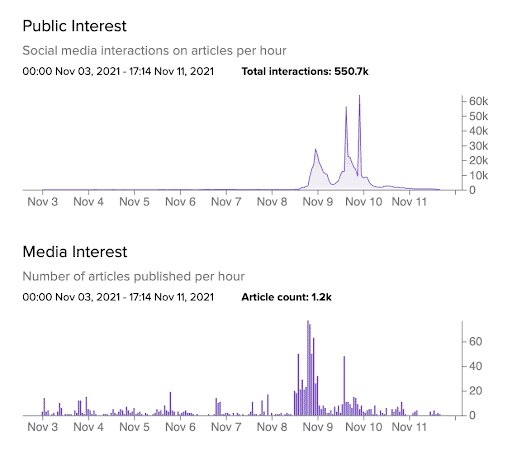
Reporting on your crisis
Once you have managed your crisis, you may want to report on it back to your team or client.
This is where our new export feature really helps you.
Like the image export, you can export the Timeline to a PowerPoint file. This .pptx file integrates with your PowerPoint themes to give you a fully customizable slide as part of your presentations.
You can also export all of the timeline data to a .csv file, so you can integrate it with any third party platform metrics you are tracking as part of the crisis, such as Google Analytics or your social channels.
And that’s a look at how you can use NewsWhip in a crisis situation, when multiple parties are involved. As you can see, there are multiple narratives involved before the crisis, and as the crisis evolves. Thanks to NewsWhip’s Timeline, you can track the impact of each narrative, every individual article, and monitor in real time as you respond right up until you’re ready to report on the crisis.
If you’d like to see how all of this can be done in more detail, contact us for a demo.






